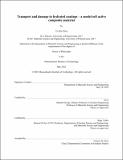| dc.contributor.advisor | Li, Ju | |
| dc.contributor.advisor | Yildiz, Bilge | |
| dc.contributor.author | Zhou, Yu Ren | |
| dc.date.accessioned | 2023-11-30T21:12:46Z | |
| dc.date.available | 2023-11-30T21:12:46Z | |
| dc.date.issued | 2022-05 | |
| dc.date.submitted | 2023-11-22T21:32:31.735Z | |
| dc.identifier.uri | https://hdl.handle.net/1721.1/153085 | |
| dc.description.abstract | Active materials are solids which cyclically absorb and release large quantities of mass and/or energy, and encompass a wide variety of materials including lithium ion battery anodes and biological matter. Four interrelated fundamental processes – transport, volume change, stress, and damage – are present in active materials. This thesis explores the interconnection of these processes using water-based anti-corrosion coatings, water-absorbing polymer films composed of coalesced latex particles, as the model active material system. The free volume theory was applied to latex particle boundary networks to understand transport which leads to volume swelling. More hydrophilic boundary networks led to higher water diffusivity due to higher free volume at these networks after water swelling. Enhancement of ion diffusivity due to free volume increase after water swelling explains the correlation between ion transport and water absorption timescales. Inplane stresses in water-based coating films during volume change induced by hydration-drying cycling were explored by in-situ measurement of in-plane stress, and ex-situ observation of surface morphology. In-plane stress relaxation was observed during the hydration half-cycle, attributed to the enhanced capacity for polymer chain motion after free volume swelling by absorbed water. Inplane tensile stress was measured at the beginning of the drying half-cycle. It was proposed that surface pit formation was due to preferential plastic deformation of more hydrated regions under in-plane tension during drying, above defects in the latex superlattice with locally faster water diffusivity. To understand stress-induced damage at the coating-steel interface, pull-off measurements were conducted to measure the adhesion force between stainless steel probes and water-based coatings. Slower degradation in adhesion force during NaCl(aq) immersion of coatings with faster water transport was explained by the faster-swelling coating surface moving more rapidly towards the dissolving probe passivating layer, thereby slowing the rate of coatingpassivating layer gap width increase. The techniques in this thesis may be applied to automated experiments which are becoming increasingly feasible with recent computational advances. | |
| dc.publisher | Massachusetts Institute of Technology | |
| dc.rights | In Copyright - Educational Use Permitted | |
| dc.rights | Copyright MIT | |
| dc.rights.uri | http://rightsstatements.org/page/InC-EDU/1.0/ | |
| dc.title | Transport and damage in hydrated coatings – a model soft active composite material | |
| dc.type | Thesis | |
| dc.description.degree | Ph.D. | |
| dc.contributor.department | Massachusetts Institute of Technology. Department of Materials Science and Engineering | |
| mit.thesis.degree | Doctoral | |
| thesis.degree.name | Doctor of Philosophy | |
